After spending a day admiring more popular geyser basins in Yellowstone National Park, including the Upper Geyser Basin with its star-performer Old Faithful, we almost skipped the Norris Geyser Basin, but changed our minds at the last minute.
Last updated: October 21, 2025
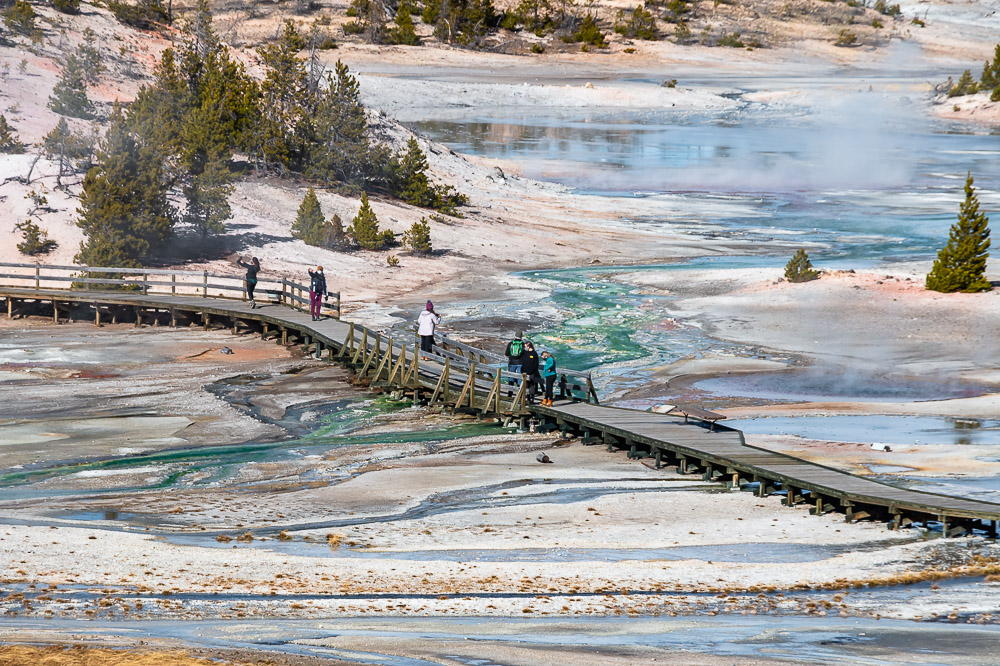
Visiting Norris Geyser Basin
I was determined to visit the Norris Geyser Basin. It was a shame to fly to Idaho, drive for more than 5 hours from Boise to Yellowstone National Park, and then leave out one of its exclusive geyser basins.
As the day was going to an end, we could find plenty of excuses to skip the Norris Geyser Basin. The site is a detour from the Grand Loop Road. If you plan to travel to the Grand Canyon of the Yellowstone and then farther north into the Montana’s side of the national park on the same day, the short trip to the Norris Basin can take an hour or longer of your precious time.
Roshan also assumed that after exploring some of the major geyser basins in Yellowstone and feasting our eyes on the park’s superstars, the predictable Old Faithful Geyser and the boiling-hot Grand Prismatic Spring, another geyser basin would pale in comparison with them.
Against our best judgement or more like skepticism at this point, we challenged ourselves to head to the Norris Geyser Basin with no expectations whatsoever. Just a quick stop before driving farther north and embarking on a hiking adventure to the breathtaking Grand Canyon of the Yellowstone.
Where Is Norris Geyser Basin Located?
The Norris Geyser Basin is one of the largest geyser basins in Yellowstone National Park. Nestled in the central section of the park, at the junction of the Grand Loop Road and Norris Canyon Road, it harbors some of the oldest and hottest geysers in the park. Across the road from the geyser basin, a few trails initiate and lead you through the basin and closer to some of its thermal features.
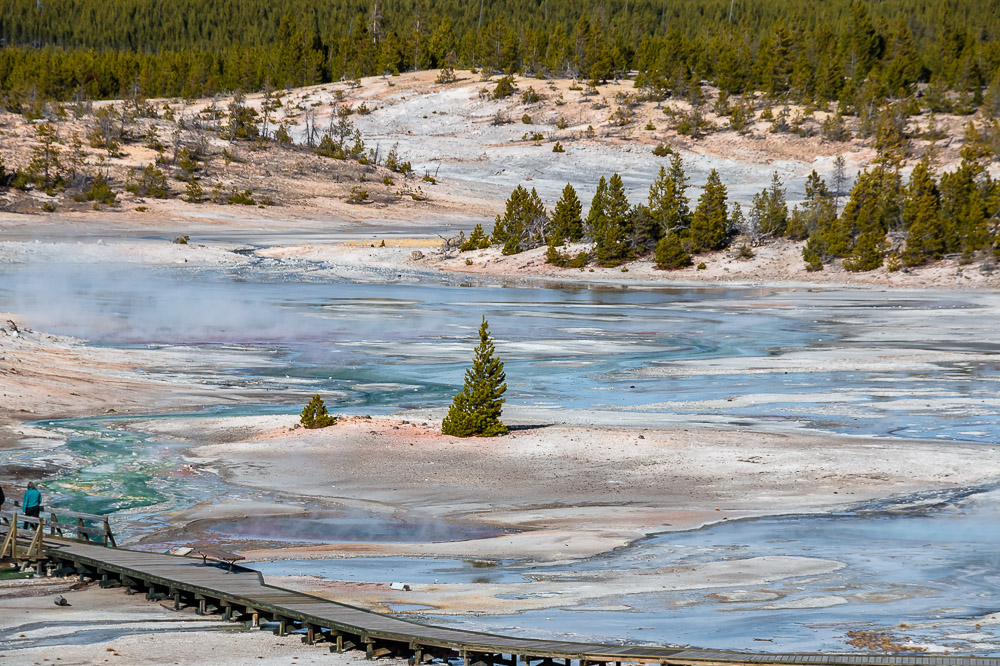
The Best Time to Visit Norris Geyser Basin
Although not as popular as the Upper Geyser Basin or the Midway Geyser Basin famous for Old Prismatic Spring, the Norris Geyser Basin can get crowded. In the summer, the parking lot in front of the rustic Norris Geyser Basin Museum is the first to experience the influx of visitors. It fills completely and stays full for hours.
The best way to avoid being held back by the discouraging parking situation is to arrive early in the morning or late in the afternoon. Alternatively, plan your trip to Yellowstone National Park during the shoulder or off-season. With just a few days left before the seasonal closure of the park, we had no issues with parking or overcrowded trails in the Norris Geyser Basin or elsewhere in the park.
The time of the day also matters. I give the due credit for our crowd-free experience at the basin to early evening hours. Some visitors walked along the raised boardwalk that winds through the basin floor packed with vibrant hot springs, hissing mud pots, and steam geysers. But it was just a tiny fraction compared to the number of people gathered in the Upper Geyser Basin earlier that day.
If you stay long enough in the area, you may even witness a geyser eruption. Yet none of the volcanic inhabitants of the area are as predictable as Old Faithful. The likelihood of witnessing a great show is minimal.
History of Norris Geyser Basin
The Norris Geyser Basin is one of the oldest areas in the national park. Some of its thermal features date back at least 115,000 years. The thermal display, however, changes daily due to the volcanic nature of the park with its frequent seismic disturbances and water fluctuations.
The basin was named after Philetus Walter Norris who observed, studied, and provided early detailed information about the area’s hydrothermal features. Norris was the second superintendent of Yellowstone National Park and the first to be paid for this position.
READ MORE: 10 Interesting Facts about Yellowstone You Didn’t Know
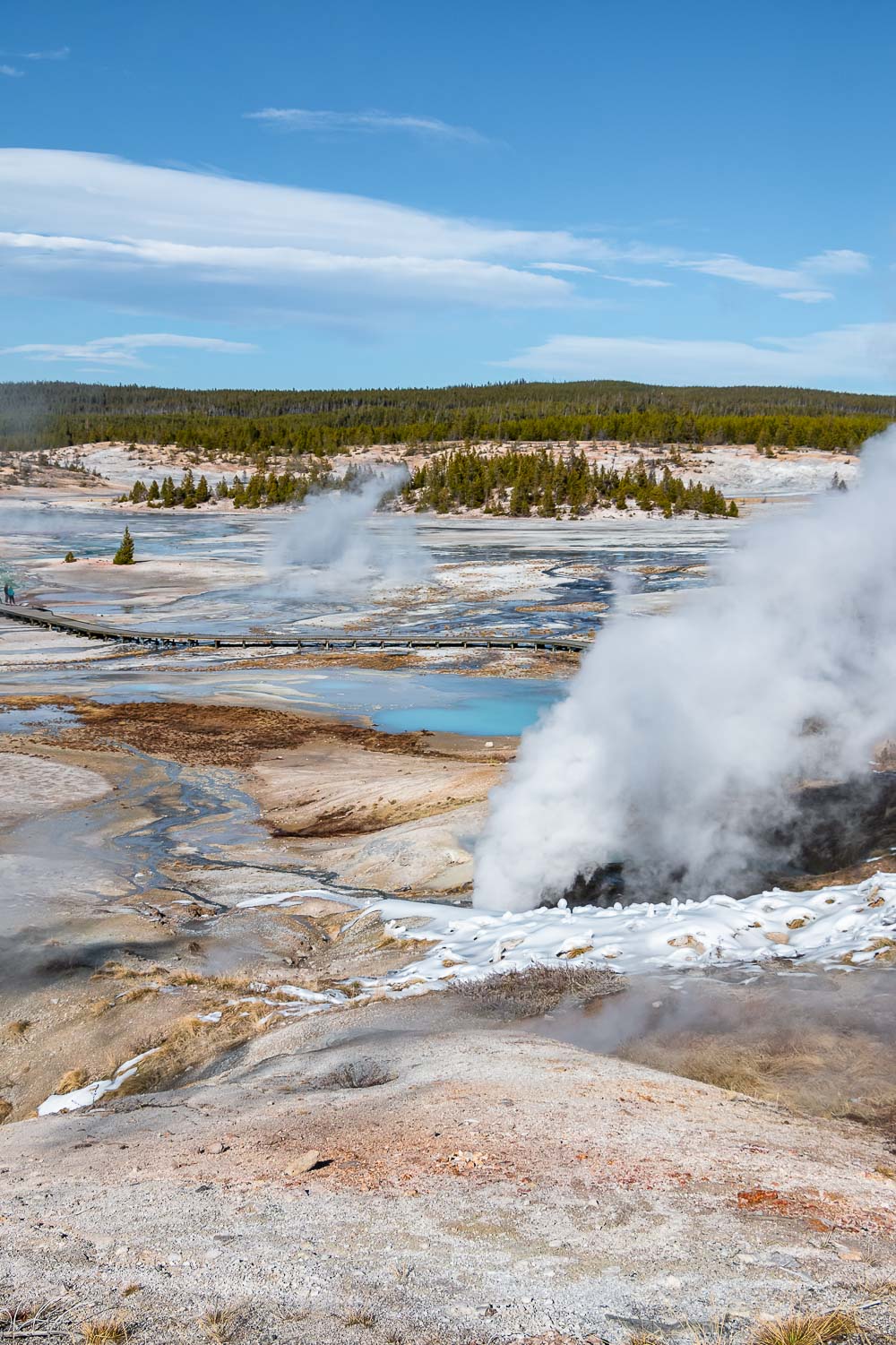
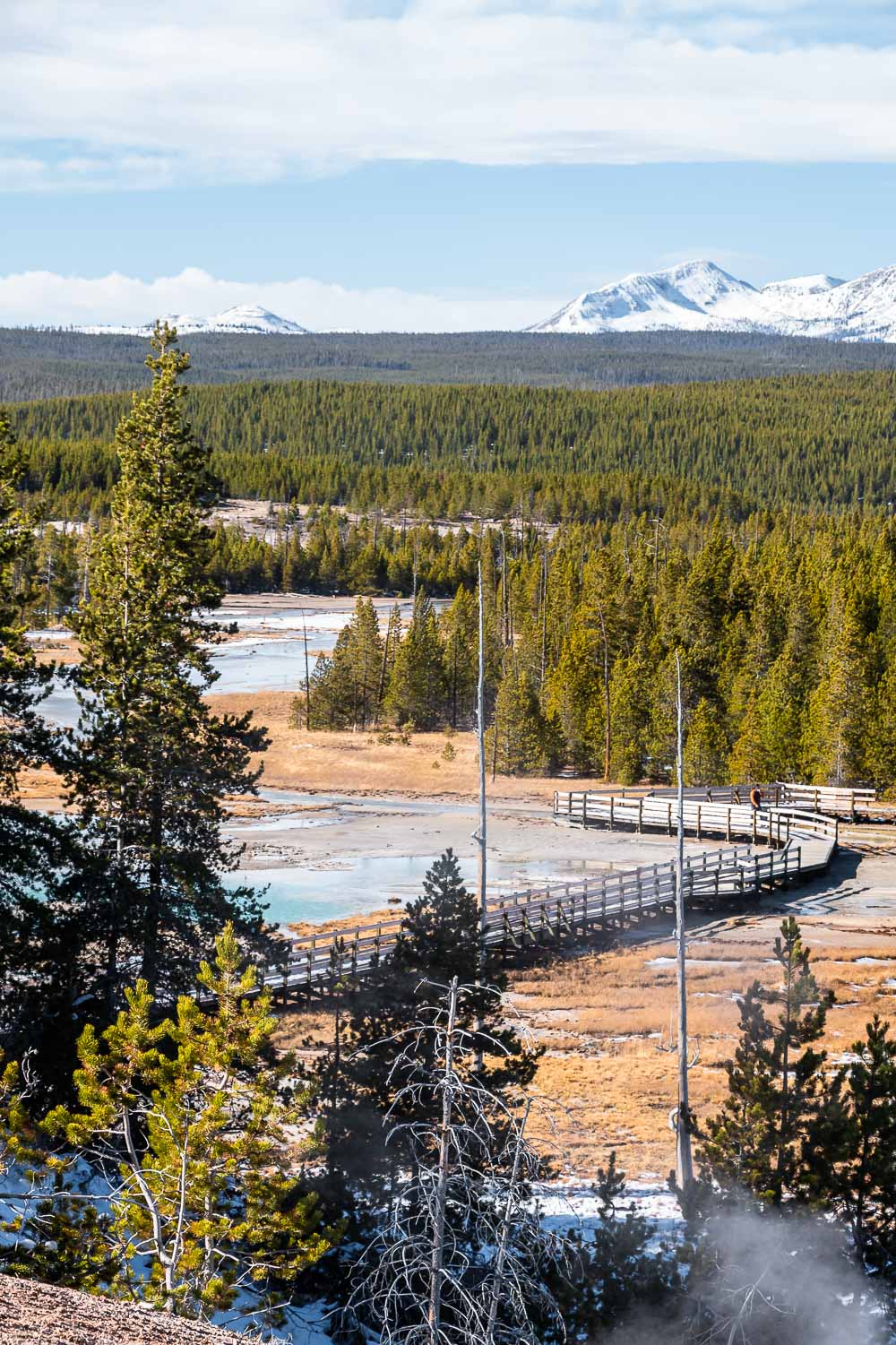
WHY SHOULD YOU VISIT NORRIS GEYSER BASIN?
So, why should you visit the Norris Geyser Basin? There are quite a number of reasons.
1. The Hottest Thermal Area in Yellowstone
The majority of the thermal features in the Norris Geyser Basin are boiling hot with the temperatures that rise well above 199°F (93°C). The recorded highest temperature was 459°F (237°C). It was measured in a scientific drill hole, just 1,087 feet (326 meters) below the surface.
2. Home to the World’s Tallest Geyser
Steamboat Geyser in the Norris Geyser Basin is known as the world’s tallest active geyser. Its major eruptions can shoot powerful jets of water that reach heights of more than 300 feet (91 meter). The eruptions, however, are unpredictable. It can take anywhere from a few days to more than a year for the next geyser “show” to follow.
Steamboat’s minor eruptions are more frequent. Once fired, the water can reach 6-40 feet in the air.
3. A Prototype for National Park Service Architecture
The open-foyer Norris Geyser Museum was built as a “trailside museum” in the 1930s. When automobiles replaced stagecoaches with guides, visitors started using the museum as a means to learn about Yellowstone and receive any information they needed for self-guided explorations.
At the time of its completion, the rustic museum piqued a lot of interest. The structure combined the elements of man-made intervention with the natural environment in a balanced blend. Its simplicity paired with the use of local materials served as a model for hundreds of rustic-style park buildings erected in the 1930s.
READ MORE: Top 12 Historic Buildings in the American West
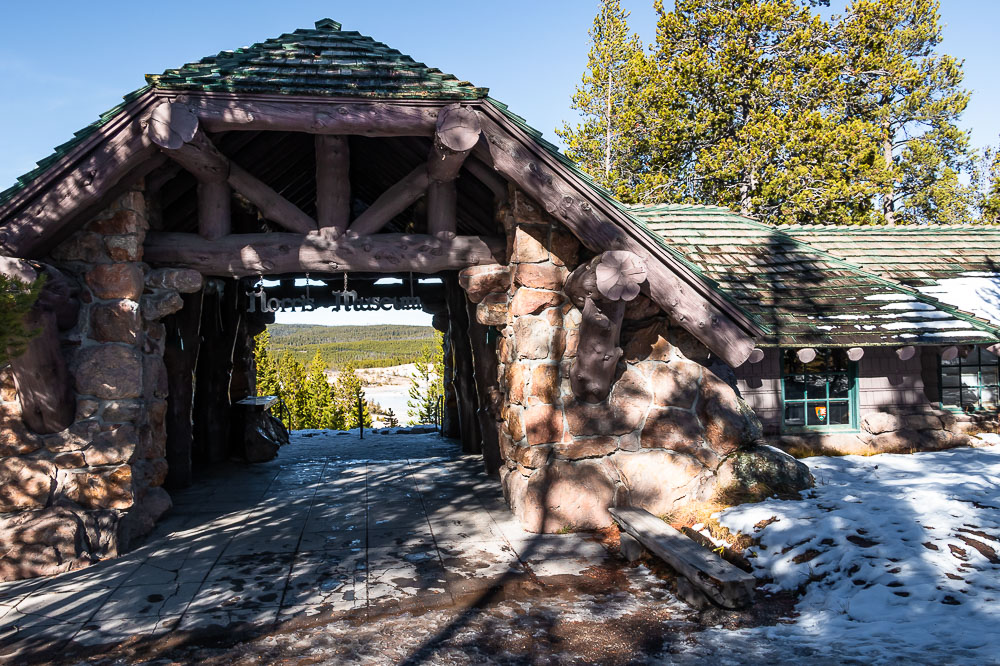
4. The Otherworldly Terrain
Located outside one of Yellowstone’s most recent calderas, the Norris Geyser Basin doesn’t look like any geyser basins in the park. Gazing down into the otherworldly realm from the overlook near the Norris Geyser Museum, you can’t help but compare it with a watercolor painting with red, blue, and purple lines traced across the canvas. No trees or bushes disturb the unique “masterpiece”.
Indeed due to the high temperature and acidic water, plants grow sporadically in the region and for the most part keep off of the colorful wasteland.
5. One of the Most Colorful Basins in Yellowstone
Behind the vivid colors of the Norris Geyser Basin stay three driving forces: the extreme environment, heat-loving microorganisms, and minerals in the hot water. Fragile bacteria thrive in the thermal features of the basis, forming colorful mats on the ground. The “porcelain” appearance with red hues is attributed to the abundance of minerals such as silica and iron oxides.
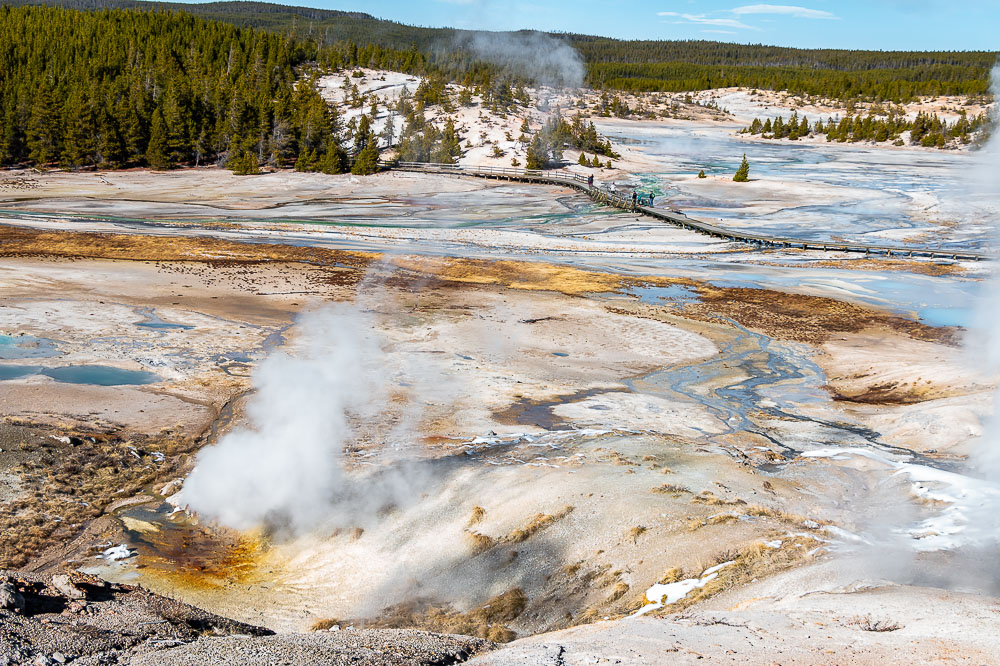
Hiking Trails
If you need to stretch your legs before heading to other sections of the park, hit one or both of these trails.
Back Basin Trail
The Back Basin Trail is an easy hike with minimum elevation change.
- Distance: 1.6-mile loop
- Difficulty: Easy
- Elevation gain: 40-55 feet
- Time: 40-50 minutes
- Trailhead: Norris Geyser Basin
Porcelain Basin
If vibrant colors is everything you are looking for, then be sure to check out the scenic Porcelain Basin. The hike along the raised boardwalk is easy and takes on average 20 minutes to complete.
- Distance: 0.6-mile loop
- Difficulty: Easy
- Elevation gain: 40-55 feet
- Time: 20-30 minutes
- Trailhead: Norris Geyser
Read Next
- GRAND TETON: How to Spend One Day in Grand Teton National Park
- GLACIER NP: The Best Time to Visit Glacier National Park: Seasonal Activities